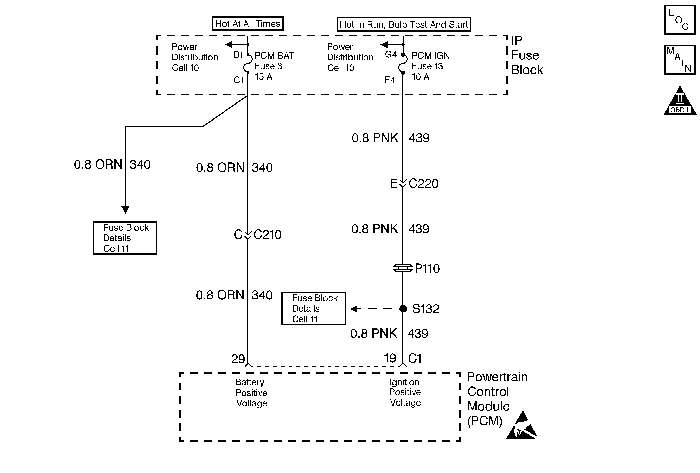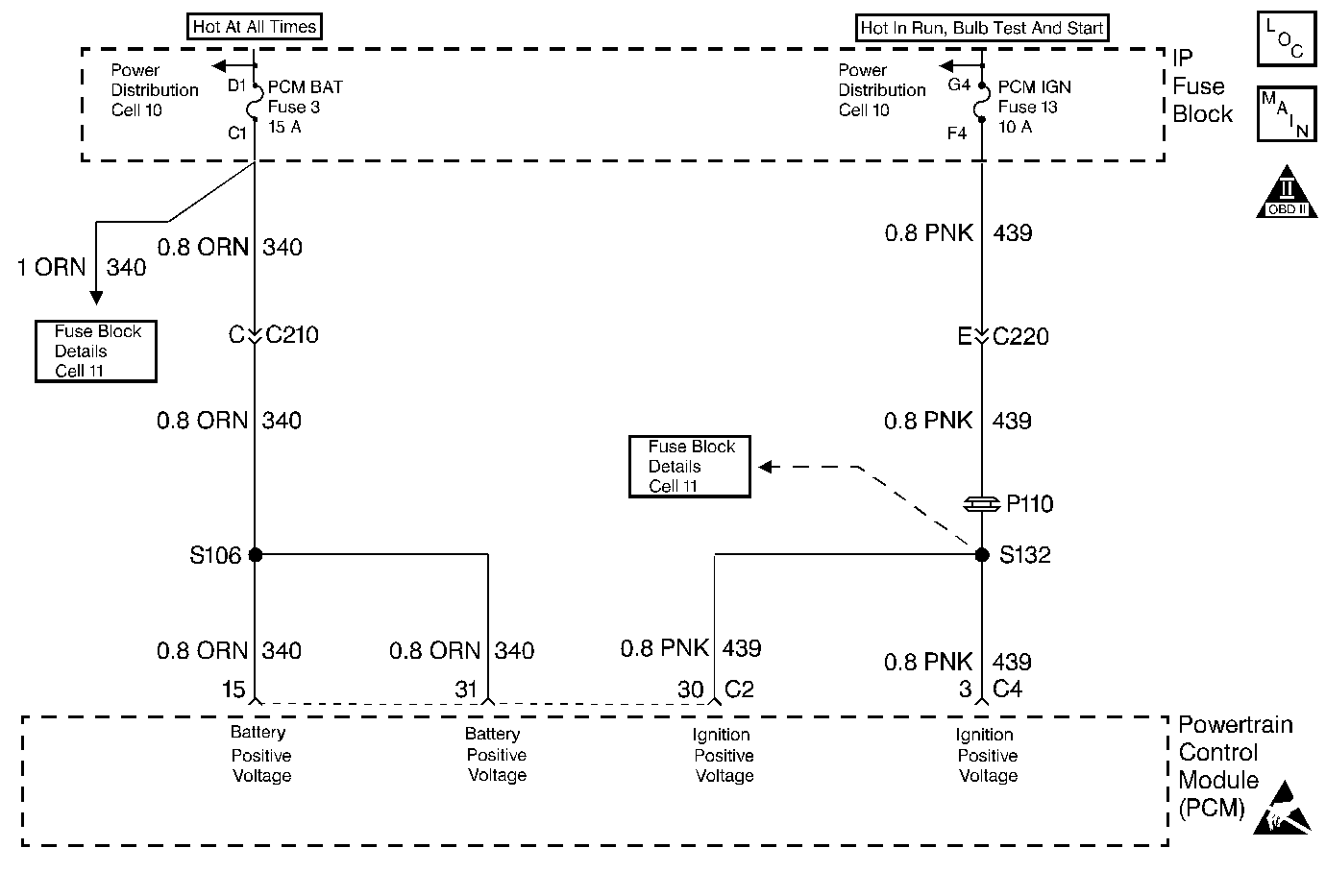DTC P0560 System Voltage 3.8L, VIN K

Circuit Description
Circuit 439 is the ignition voltage feed for the PCM. Circuit 340 is the battery voltage feed for the PCM.
If the PCM detects a low voltage and a high voltage, then DTC P0560 sets. DTC P0560 is a type D DTC.
Conditions for Setting the DTC
The system voltage is low:
| • | The engine speed is greater than 800 RPM. |
| • | The system voltage is less than 10 volts. |
| • | All conditions are met for 2 seconds. |
The system voltage is high:
| • | The system voltage is greater than 16 volts. |
| • | The TFT is greater than 0°C (32°F). |
| • | All conditions are met for 2 seconds. |
Action Taken When the DTC Sets
| • | All transmission output devices are OFF. |
| • | The PCM does not illuminate the Malfunction Indicator Lamp (MIL). |
Conditions for Clearing the DTC
| • | A scan tool can clear the DTC from the PCM history. The PCM clears the DTC from the PCM history if the vehicle completes 40 warm-up cycles without a failure reported. |
| • | The PCM cancels the DTC default actions when the fault no longer exists and the ignition is OFF long enough in order to power down the PCM. |
Diagnostic Aids
| • | Charging the battery with a battery charger may set DTCs. Jumpstarting an engine may falsely set DTCs. |
| • | If DTCs set when you operate an accessory, inspect the applicable wiring for faulty connections, and excessive current draw. |
| • | Inspect the starter solenoid for faulty connections. Examine the starter solenoid fusible link. |
| • | Inspect the generator for a damaged terminal. |
| • | Inspect the accessory belts for damage. Check the belts for correct tension. |
Test Description
The numbers below refer to the step numbers on the diagnostic table.
-
This step tests the charging system voltage.
-
This step tests the battery voltage input at the PCM.
-
This step tests the ignition voltage input at the PCM.
Step | Action | Value(s) | Yes | No | ||||||
|---|---|---|---|---|---|---|---|---|---|---|
1 | Was the Powertrain On-Board Diagnostic (OBD) System Check performed? | -- | Go to Powertrain On Board Diagnostic (OBD) System Check , Section 6. | |||||||
2 |
Important: Before clearing DTCs, use the scan tool in order to record the Freeze Frame and the Failure Records for reference. The Clear Info function will erase the data. Important: If any other DTCs are present, refer to the applicable diagnostic tables before continuing. Is the measured voltage higher than the specified value? | 10.5 volts | Go to Battery Diagnosis, Section 6 | |||||||
3 | Start the engine. Warm the engine to the normal operating temperature. Did the SERVICE ENGINE SOON lamp illuminate? | -- | Go to Charging System Diagnosis, Section 6 | |||||||
Is the system voltage within the specified range? | 13-15 volts | Go to Charging System Diagnosis, Section 6 | ||||||||
Is there a voltage variance between the voltage measured at the battery (taken in Step 2) and at terminal C1-20 that is greater than the specified value? | 0.5 volts | |||||||||
6 | Repair the high resistance in circuit 340 (ORN). Refer to Electrical Diagnosis, Section 8. Have you repaired the circuit? | -- | -- | |||||||
Is there a voltage variance between the voltage measured at the battery (taken in Step 2) and at terminal C1-20 that is greater than the specified value? | 0.5 volts | |||||||||
8 | Repair the high resistance in circuit 439 (PNK). Refer to Electrical Diagnosis, Section 8. Have you repaired the circuit? | -- | -- | |||||||
9 | Examine PCM connector terminal C1-19 and terminal C1-20 for the following problems:
Did you find and correct a problem? | -- | ||||||||
10 | Replace the PCM. Refer to Powertrain Control Module Replacement/Programming , Section 6. Is the replacement complete? | -- | -- | |||||||
11 |
Has the test run and passed? | -- | System OK |
DTC P0560 System Voltage 5.7L, VIN P

Circuit Description
Circuit 439 is the ignition voltage feed for the PCM. Circuit 340 is the battery voltage feed for the PCM.
If the PCM detects a low voltage and the PCM detects a high voltage, then DTC P0560 sets. DTC P0560 is a type D DTC.
Conditions for Setting the DTC
The system voltage is low:
| • | The engine speed is greater than 1000 RPM. |
| • | The system voltage is less than 10 volts at a maximum transmission temperature of 150°C (302°F). |
| • | The system voltage is less than 7.3 volts at a minimum transmission temperature of -40°C (-40°F). |
| • | All conditions are met for 4 seconds. |
A high system voltage causes DTC P0560 to set, if the system voltage is greater than 17 volts for 2 seconds.
Action Taken When the DTC Sets
| • | All transmission output devices are OFF except the TCC PWM Solenoid Valve and the 3-2 Shift Solenoid Valve Assembly. |
| • | The PCM freezes shift adapts from being updated. |
| • | The PCM does not illuminate the Malfunction Indicator Lamp (MIL). |
Conditions for Clearing the DTC
| • | A scan tool can clear the DTC from the PCM history. The PCM clears the DTC from the PCM history if the vehicle completes 40 warm-up cycles without a failure reported. |
| • | The PCM cancels the DTC default actions when the fault no longer exists and the ignition is OFF long enough in order to power down the PCM. |
Diagnostic Aids
| • | Charging the battery with a battery charger may set DTCs. Jumpstarting an engine may falsely set DTCs. |
| • | If DTCs set when you operate an accessory, inspect the applicable wiring for faulty connections, and excessive current draw. |
| • | Inspect the starter solenoid for faulty connections. |
| • | Examine the starter solenoid fusible link. |
| • | Inspect the generator for a damaged terminal. |
| • | Inspect the belts for damage. |
| • | Inspect the belt for correct tension. |
Test Description
The numbers below refer to the step numbers on the diagnostic table.
-
This step tests the charging system voltage.
-
This step tests the battery voltage input at the PCM.
-
This step tests the ignition voltage input at the PCM.
Step | Action | Value(s) | Yes | No | ||||||||||||||
|---|---|---|---|---|---|---|---|---|---|---|---|---|---|---|---|---|---|---|
1 | Was the Powertrain On-Board Diagnostic (OBD) System Check performed? | -- | Go to Powertrain On Board Diagnostic (OBD) System Check , Section 6 | |||||||||||||||
2 |
Important: Before clearing DTCs, use the scan tool in order to record the Freeze Frame and the Failure Records for reference. The Clear Info function will erase the data. Important: If any other DTCs are present, refer to the applicable diagnostic tables before continuing. Is the measured voltage higher than the specified value? | 10.5 volts | Go to Battery Diagnosis, Section 6 | |||||||||||||||
3 | Start the engine. Warm the engine to the normal operating temperature. Did the generator (check engine) lamp illuminate? | -- | Go to Charging System Diagnosis, Section 6. | |||||||||||||||
Is the system voltage within the specified range? | 13-15 volts | Go to Charging System Diagnosis, Section 6 | ||||||||||||||||
Is there a voltage variance between the voltage measured at the battery (taken in Step 2) and at the terminals C2-15 and C2-31 that is greater than the specified value? | 0.5 volts | |||||||||||||||||
6 | Repair the high resistance in circuit 340 (ORN). Refer to Electrical Diagnosis, Section 8. Have you repaired the circuit? | -- | -- | |||||||||||||||
Is there a voltage variance between the voltage measured at the battery (taken in Step 2) and at terminals C2-30 and C4-3 that is greater than the specified value? | 0.5 volts | |||||||||||||||||
8 | Repair the high resistance in circuit 439 (PNK). Refer to Electrical Diagnosis, Section 8. Have you repaired the circuit? | -- | -- | |||||||||||||||
9 | Examine the following PCM connector terminals.
Inspect each of the terminals for the following problems:
Did you find and correct a problem? | -- | ||||||||||||||||
10 | Replace the PCM. Refer to Powertrain Control Module Replacement/Programming , Section 6. Is the replacement complete? | -- | -- | |||||||||||||||
11 |
Has the test run and passed? | -- | System OK |
